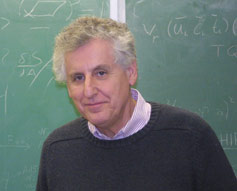

Thursday - April 8, 2010
SLAC Today is
available online at:
http://today.slac.stanford.edu
In this issue:
People: The Brodsky 500
DOE/INFN Undergraduate Summer Exchange
 |
 |
|
Thursday - April 8, 2010 |
People: The Brodsky 500 You can't put a price on hard work, but sometimes you can put a publication number on it. SLAC physicist and faculty member Stan Brodsky recently reached his 500th publication on the SPIRES database, an open-source site hosted by the SLAC National Accelerator Laboratory. SPIRES includes most peer-reviewed journal papers from the field of high-energy physics, as well as unpublished papers, meeting presentations, white papers, and other publications. At the age of 70, Brodsky says he has no intention of slowing down his workflow. Brodsky began his career at SLAC in 1966, just two years after earning his PhD in quantum electrodynamics, the theory underlying atomic physics. At SLAC he began to investigate the quantum physics of hadrons with the SLAC Theoretical Physics Group. "Working at SLAC is an extraordinary opportunity," Brodsky says. "I can work on what I think is most important, and what leads to the most innovation, and topics that I think are the most interesting." Brodsky is co-author of one of the 50 top-cited SPIRES papers of all time, a list which represents the top cited high-energy physics papers for as long as it has been a field of science. The article, published in 1980 with co-author Peter Lepage, reported work on fundamental processes in quantum chromodynamics, or QCD. QCD theory was created to explain the interactions among quarks and gluons, the particles that make up protons and neutrons, which in turn make up the nuclei of all atoms. Brodsky has published many other influential and highly cited papers in QCD and quantum field theory throughout his career, and in 2007 he received the J. J. Sakurai Prize for Theoretical Particle Physics of the American Physical Society. The prize is regarded as one of the top honors in high-energy physics. (See "SLAC Theoretical Physicist Stanley J. Brodsky Awarded Sakurai Prize" for more on his prizewinning work.) Among other things, Brodsky gives credit for his high productivity to his many outstanding collaborators. In addition to working with other QCD and quantum physicists, Brodsky keeps abreast of developments in other areas of physics, and finds connections to his own work, opening the door for new collaborations and innovations. He said another key has been the dawn of the Internet age, which allows him to work with scientists all over the world. "It can make you more productive if you work with someone in the US, someone in Europe, and someone in Korea," he says. "It means we can work 24 hours a day!" Brodsky and his wife are now in Denmark for three months, where Brodsky is serving as the visiting Hans Christian Andersen Professor at the new Center for Particle Physics and Phenomenology (CP3-Origins) of Southern Denmark University. He will return to SLAC in July and resume his position as faculty member and theoretical physicist. As for thoughts of retirement, Brodsky only says, "It would be hard to give up the world's best job." DOE/INFN Undergraduate Summer ExchangeCalling all undergraduates in at least their third year with backgrounds and interest in physics, engineering or computing studies, and the desire to combine research and travel! The Summer Exchange Program offers a marvelous opportunity to work directly with scientists in Italy and to absorb the rich culture there. The deadline for applications is April 18. The exchange, sponsored by the U.S. Department of Energy Office of Science and Italy's National Institute for Nuclear Physics, sends U.S. undergraduate students to Italy for eight to ten weeks to work with scientists on projects. Italian students have similar opportunities stateside. Potential research areas include particle physics, astro-particle physics, nuclear physics, theoretical physics, and detector physics. Information about the Italian program may be found on the DOE/INFN Summer Exchange Program 2010 call for applications. Information about the DOE program at SLAC may be found on the SLAC/INFN Summer Exchange Program page. For additional information, contact Harvey Lynch (x3691). Ciao! |
Events
Access (see all)Announcements
|
|
| | ||
|
|
||
 <%
Response.AddHeader "Last-modified", getArticleDate()
'Response.AddHeader "Last-modified","Mon, 01 Sep 1997 01:03:33 GMT"
'Monday, December 06, 2010
%>
<%
Response.AddHeader "Last-modified", getArticleDate()
'Response.AddHeader "Last-modified","Mon, 01 Sep 1997 01:03:33 GMT"
'Monday, December 06, 2010
%>View online at http://today.slac.stanford.edu/. |
||